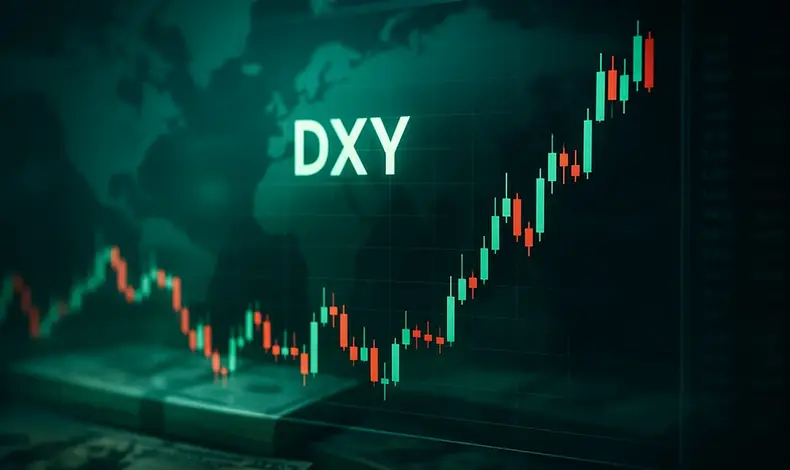Forex
+100 assets
Content table
2 mounts ago
5 min read
Written by Greenup24
The U.S. Dollar Index is one of the most widely used tools for gauging the market’s strength and appetite for the U.S. dollar. This index measures the dollar’s performance live against a defined basket of major global currencies and lets traders track the trend in the value of the world’s most-traded currency.
Because the dollar plays a central role in global transactions, the index is not only a tool for analyzing the FX market but is also recognized as a standalone market. Examining changes in this index can provide valuable clues for making currency-trading decisions.
The ticker DXY refers to the U.S. Dollar Index a measure that tracks the dollar’s value against six major foreign currencies. The goal is to provide a clear picture of the dollar’s standing in global markets. When the dollar strengthens against these currencies, DXY rises; when the dollar weakens, the index falls.
Among FX traders, this index is known not only by the symbol DXY but also as USDX, and even by the informal nickname “Dixie.”
The index compares the dollar’s value to six major global currencies: the euro (EUR), Japanese yen (JPY), British pound (GBP), Canadian dollar (CAD), Swedish krona (SEK), and Swiss franc (CHF). This composition was chosen in 1974, when the index was created.
The only major change to the basket came in 1999, when the euro replaced a set of European currencies such as the German mark, French franc, and Italian lira.
However, many of the United States’ major trading partners including China and Mexico are not represented in the index. For that reason, some experts have suggested that currencies like the Chinese yuan (CNY) and Mexican peso (MXN) replace the Swiss franc and Swedish krona, or that the basket be broadened to include more currencies.
The Dollar Index was launched with a base value of 100, and all subsequent moves are calculated relative to that level. Simply put, a reading above 100 indicates a stronger dollar than at the base date, while a reading below 100 indicates a weaker dollar.
To start trading the Dollar Index, first register with GreenUp24 and open a trading account to access the tools required to trade this index. Since, like other indices, there is no independent physical market for buying and selling DXY, you need to use derivatives such as CFDs or futures.
If you are bullish on the dollar, you can open a long position on the index to profit if it rises and incur losses if it falls. Conversely, if you expect the dollar to weaken, you can short the index to benefit from a decline.
A common way to use DXY is hedging against changes in the dollar’s value. For example, if you worry that a stronger U.S. dollar could drag down the value of your equity portfolio, you can buy the Dollar Index to offset that risk; in this way, part of any potential loss in stocks may be offset by gains on your index position.
The index is calculated from the exchange rate of each currency in the basket, weighted by its assigned coefficient. These weights give more influential currencies, such as the euro, a larger impact on the final index level, while smaller components like the Swedish krona have less effect.
As you can see, the EUR/USD pair has the largest share even larger than the sum of the other currencies because several former European currencies (like the German mark and French franc) were consolidated into the euro, and because the European Union is a key U.S. trading partner.
USDX = 50.14348112 × (EUR/USD)^(-0.576) × (USD/JPY)^(0.136) × (GBP/USD)^(-0.119) × (USD/CAD)^(0.091) × (USD/SEK)^(0.042) × (USD/CHF)^(0.036)
Important note: The negative exponents appear where the dollar is the quote currency in the pair, while pairs in which the dollar is the base currency (such as USD/JPY and USD/CHF) carry positive exponents.

The U.S. Dollar Index was launched in 1973 after the end of the Bretton Woods Agreement. That agreement among central banks coordinated monetary policies of sovereign countries and facilitated trade and financial cooperation among the United States, Canada, Western European countries, and Australia.
Following the collapse of Bretton Woods, the gold standard which had directly linked the dollar’s value to gold also ended. Creating the Dollar Index provided a way to measure the value of the world’s reserve currency (USD) in a free market.
Since 1985, the index has been administered by the Intercontinental Exchange (ICE).
Unlike many financial indices that have trended steadily upward over time, the Dollar Index has experienced pronounced fluctuations since its inception.
Because the index began at a base of 100, comparing the current reading with that level quickly shows whether the dollar is stronger or weaker today than it was in 1974.
Movements in the USDX are typically driven by macroeconomic factors, including:
Another important factor is safe-haven flows. During periods of economic uncertainty or global crises, demand for the U.S. dollar tends to rise and the index increases. Conversely, when risk-on sentiment prevails, investors may sell dollars and shift toward riskier assets, pushing the index lower.
The U.S. Dollar Index is a key tool for gauging the USD’s strength against major global currencies and plays a crucial role in analyzing FX market trends. Understanding its structure, history, and the drivers of its movements gives traders a sharper edge in decision making.
To closely monitor and analyze the Dollar Index’s moves and their impact on your trades, open an account with GreenUp24 now and start using advanced analytical tools.

